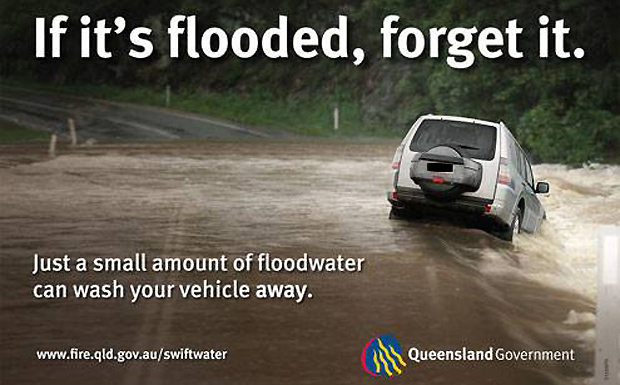
January 10, 2016
The Queensland Floods Commission of Inquiry’s final report makes sombre reading on this fifth anniversary of the 2010-11 floods.
The floods affected more than 78 per cent of Queensland and 33 people died, including a 19-year-old woman at Cherbourg who drowned in Barambah Creek.
And at the time the Commission handed down its report, three people were still officially listed as missing with authorities saying it was unlikely their bodies would ever be found.
The sad fact is that at least of the some of the deaths were probably avoidable with, as the Inquiry’s report says, “a greater exercise of judgment”.
Some involved swimmers in swollen creeks and drivers attempting to cross flooded causeways,
And tragically, some involved elderly people with mobility issues trapped inside their homes.
- External link: Queensland Floods Commission Final Report
* * *
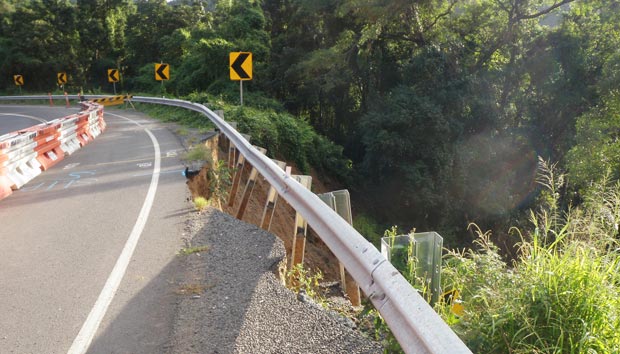
How The Individual Tragedies Unfolded
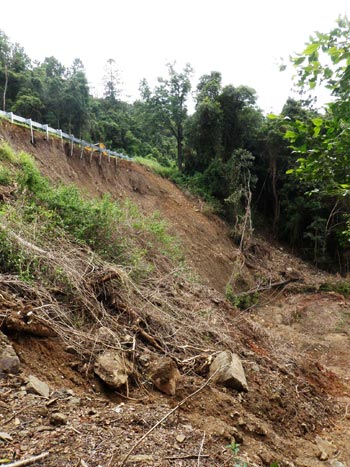
- Che-Nezce Perrie Shepherd, 17, was swimming with friends on December 12, 2010, in Alligator Creek in Cape Bowling Green National Park. Her leg became trapped between rocks while she was sliding down rapids; her friends and others who tried to help could not extricate her. Heavy rainfall in the area caused the water level in Alligator Creek to rise rapidly, drowning Ms Shepherd as she remained unable to free herself. Ms Shepherd’s friends had difficulty contacting emergency services because of the lack of phone reception in that part of the park, and the area was accessible only on foot.
- Dale Justin Peake, 29, was kayaking at Barron Falls, Kuranda on December 15, 2010. He was an experienced kayaker who had checked his safety equipment and discussed his planned route with his friends. He kayaked down one of the falls, but was not seen to surface at the bottom. Mr Peake’s body and kayak were recovered the following day; an autopsy showed that he had drowned. The area had been subject to heavy rainfall over the previous few weeks and the water levels were higher than usual.
- Andrew Donald Devencorn, 20. On December 20, 2010, he jumped into the Brisbane River at Sherwood Forest Park for a swim. He was last seen being washed downstream in a strong current. Mr Devencorn’s body was located three days later at Canoe Reach, Yeronga.
- Nelson Simon Gutchen, 50, left his niece’s house after Christmas dinner, intending to visit a friend. To reach his destination he tried to cross a flooded footbridge over Granite Creek. His body was found in the creek three days later; he had drowned.
- Berlene Faye Murray, 19, jumped from a bridge railing into Barambah Creek at Cherbourg on January 8, 2011. The creek was flooded and the current strong. Ms Murray’s body was found 200 metres downstream the same day.
- Navina Friedericke Villinger, 19, was a German holidaying in Queensland. On the late afternoon of January 10, 2011, she and some friends visited Granite Gorge Nature Park, near Mareeba. She and a friend were wading in rapidly flowing water. Her friend heard her call for help just before she disappeared beneath the water. Searches by police, SES members and a Queensland Fire and Rescue Service swift water rescue team that evening and night were unsuccessful. It was not until two days later that Ms Villinger’s body was found. An autopsy showed she had drowned.
- Van Toan Giang, 25, drowned attempting to reach his workplace on January 13, 2011. He disappeared while trying to swim across floodwaters covering Bowhill Road, Willawong, about 7:15am to reach his place of employment. His body was found in the floodwaters later that morning.
- Kay Lorraine Joy, 55, left her home in the morning of November 30, 2010, to travel to Dysart. There had been a great deal of rain in the Dysart area over the previous days, and rain continued to fall heavily that day. Many roads were cut; the local council had erected “road closed” signs on flooded roads. Mrs Joy’s vehicle became stuck in floodwaters in the middle of a creek crossing where “road closed” signs were in place. The water at the crossing was flowing rapidly, about one metre high and 15 metres wide. Police and Queensland Fire and Rescue Service officers were unable to reach Mrs Joy. Her body was recovered the following day.
- Alan William Kane, 81, attempted to drive across a flooded causeway crossing Station Creek near his home at Bajool on the evening of December 3, 2010. A witness saw his car swept away into the creek. It floated for some distance before disappearing under the water, which was muddy, deep and flowing rapidly. Mr Kane was found in the vehicle, drowned, the next day. According to the police who investigated the accident, the water at the causeway was between one and two metres higher than its normal level. There were no warning signs at the causeway; according to the Rockhampton Regional Council, the creek rises and falls so quickly that there is little opportunity to erect temporary signs. Because of its low traffic volume, the local community was familiar with its propensity to flood: local people regularly used the causeway although the creek was flowing over it.
- Richard Christian Baker, 58, was carrying stock to a location near Clermont on December 7, 2010, when he drove his truck into a flooded causeway which reportedly had about two metres of water over it. The truck was swept away and was found the following day with Mr Baker’s body in it, 50 to 60 metres from the causeway, in five metres of water.
- Donna Marie Chong, 41. On January 1, 2011, she was travelling with her husband, her two children and nephew to Burketown in a 4WD vehicle, in convoy with another family, also in a 4WD. The second family consisted of two adults and two children; the parents and siblings of Ms Chong’s nephew travelling in her vehicle. At about 7:00pm they arrived at the Leichardt River crossing, about 71km south-east of Burketown. The crossing is a cement causeway about 200 metres wide, with guide markings. Ms Chong’s husband, who was driving, saw a marker indicating the water depth was 200mm and entered the crossing. Some way on he saw a second marker indicating that it was 500mm, and decided to turn back. As he tried to put the vehicle in reverse, its front right wheel slipped off the causeway into deep water and it started to float away. He and Ms Chong got themselves and the children out of the vehicle. Ms Chong’s husband managed to hold on to a tree with two of the children. He last saw her floating past him with the third child on her back. At 8:00pm, police were contacted; they arrived at about 8:50pm and saw a car in the middle of the causeway. Markings indicated the water level was 700mm. Everyone involved was rescued except for Ms Chong. Her body was located approximately two kilometres downstream from where she was last seen; she had drowned.
- John Charles Graham, 61, was a rear-seat passenger in a 4WD vehicle travelling from Victoria to Townsville on January 2, 2011. At Aramac, the vehicle’s driver decided to take the Aramac Torrens Creek Road to Townsville (a shorter route), although a sign at the edge of Aramac indicated it was closed by flooding. The vehicle was washed off a single lane bridge over which water was flowing at a depth of 600-700mm into Cornish Creek. Both the driver and front passenger escaped the vehicle, but Mr Graham did not. His body was found three days later, out of the vehicle and some 100m from the bridge.
- James Cole Perry, 34. On January 10, 2011, he was returning with his wife and young son from the Gold Coast to Toowoomba. At about 3:00pm, near Helidon on the Warrego Highway they encountered water across the road. Mr Perry initially drove their station wagon into the water, thinking it was not deep, before attempting to reverse out of it. The vehicle stalled and was washed off the highway. It floated towards Lockyer Creek. As the water rose on the vehicle, its three occupants climbed onto its roof; but they were forced to jump from it into floodwaters as it neared downed power lines. Mr Perry’s wife last saw her husband holding their son and the vehicle. She was able to catch hold of a tree and was eventually rescued. Her son was found alive, holding onto the top of a cattle feed bin well down Lockyer Creek towards Grantham. Mr Perry has not been found; it seems he was able to save his son, but not himself.
- Robert Gregory Bromage, 50. In the early hours of January 11, 2011, he set off in his sedan to buy food. His movements after that are not known; at about 8:30am he used his mobile phone to call a mechanical repairs business. At just after 10:00am a police officer saw his car being washed along in floodwaters at Karrabin. An immediate search did not find him, but the following day the car was found, with Mr Bromage’s body inside it.
- Robert John Kelly, 30, intended to drive his station wagon from Toowoomba to Gracemere, near Rockhampton. Many of the roads he had to travel on were flooded. Shortly after 2:00pm on January, 12, 2011, he telephoned a friend and said he was about five hours away from Rockhampton. The call ended abruptly when Mr Kelly said that he had just hit water. The friend tried, unsuccessfully, to call him back. Mr Kelly was found the next day, in his submerged vehicle in Myall Creek along the Brymaroo Irvingdale Road, Brymaroo.
- Donna Maree Rice, 43, and her 13-year-old son Jordan drowned on January 10, 2011, after their vehicle was inundated by floodwaters while stalled at a Toowoomba intersection. Their call, through the 000 emergency number, to the police met with no appropriate response.
- Sandra Christine Matthews, 46, and her husband, Steven Noel Matthews, 56, were at their home at Spring Bluff on January 10, 2011, with their son and daughter, aged 20 and 15. The Spring Bluff area had been subjected to heavy rainfall throughout December 2010 and early January 2011. Between 1:00pm and 2:00pm, the rain was extremely heavy, and Murphys Creek, which ran next to the Matthews’ property, began to rise and entered the house. The Matthews children were able to get into the ceiling cavity, but their parents were swept away when the water demolished the eastern wall of the house. The bodies of Mr and Mrs Matthews were found later that day, about two kilometres downstream.
- Selwyn Hector Schefe, 52, his wife, and six-year-old daughter Katie Louise Schefe, lived at Watts Road, Murphys Creek, in a house about 20 metres from the creek. On the afternoon of January 10, the water came rapidlyup from the creek and into the house. Mr and Mrs Schefe decided to evacuate. With difficulty because of the water’s pressure, they managed to get their daughter out of the house. The three climbed into the rear tray of their utility, parked outside. The vehicle itself began to float away. Mrs Schefe was thrown out of the tray when it suddenly tilted. She last saw her husband still in the utility’s tray, holding Katie. Both were drowned; Katie’s body was found in Murphys Creek, about 3.5km downstream; Mr Schefe’s body was found 50km away.
- Sylvia Helen Baillie, 72, lived on Murphys Creek Road at Postman’s Ridge. Her house was between 10 and 20 metres from Rocky Creek. Mrs Baillie was concerned about water rising fast from the creek on the afternoon of January 10, 2011, and was making preparations to evacuate. She was last seen at her front door at about 2:10pm on January 10, just before water engulfed the house, demolishing a wall, and swept it away. Mrs Baillie’s body was found in Grantham, about 15.5km away.
- Bruce William George Warhurst, 60, also lived at Murphys Creek Road, Postman’s Ridge, with his family on a property which adjoined Rocky Creek. The house itself was between 60-80m from the creek. At 2:08pm on January 10 he spoke to his wife, who was stranded in her vehicle by landslides on the Toowoomba Range. A witness saw Rocky Creek burst its banks about 2:30pm. Shortly after, the same witness saw a wave of water from the creek wash the Warhurst house away. Mr Warhurst’s body was found six kilometres away, at Helidon Spa.
- Reinskje (Regina) Van der Werff, 82, suffered from a number of conditions which affected her mobility, and used a walking frame. On the afternoon of January 10, she was at home with her daughter, grandson and three great-grandchildren at their residence on the Gatton-Helidon Road at Grantham. At about 3:00pm, a male relative rang to advise the family that they should get onto the roof of their house because there was a lot of water coming towards Grantham. It was impossible for Mrs Van der Werff to climb a ladder; her daughter managed as best she could by helping her onto a table before getting herself and her children onto the roof, from where they were later rescued by helicopter. The water rose to within a metre of the ceiling. Mrs Van der Werff’s body was found some days later, still in the house.
- Bruce Allan Marshall, 66, also lived on the Gatton-Helidon Road with his wife and son, in a low-set house. He also suffered from medical conditions affecting his mobility. On January 10, his wife and son had gone to Toowoomba. At 4:03pm, Mr Marshall telephoned his daughter. In the course of their conversation, he told her that water had reached the top step of the house and was starting to come up through the floor boards; he was going to ring the SES for assistance. That conversation was followed by a number of calls made by Mr Marshall to the ‘000’ emergency number, which were put through to police, the last at 4:18pm. In those calls, Mr Marshall gave an account of increasing desperation: the water had come up to his waist, then to his shoulders; he could not get out of the house. His body was found in the house on the following day.
- Llync-Chiann Armana Omega Clarke-Jibson, 31, and her children, Jocelyn Elenor Jibson, 5, and Garry Daniel Jibson, 11, died in an attempt to escape the flooding which hit Grantham on January 10. Ms Jibson’s husband, Daniel McGuire, was a member of the Grantham Rural Fire Service. He attempted to evacuate the family in a rural fire truck. Water hit the truck, washing it off the roadway. It rapidly became inundated. MrMcGuire managed to save son Zachary, 7, but he was unable to rescue the other members of the family, who were trapped in the truck. Queensland Fire and Rescue Service members found the truck, and the bodies of Ms Jibson, Jocelyn and Garry, in the truck, that night.
- Jean Gurr, 88, also lived on the Gatton-Helidon Road. Mrs Gurr walked with the aid of a walking stick. On the afternoon of January 10 she made two unanswered telephone calls to a family member at 4:05pm and 4:10pm. Her house, which was on stumps about half a metre high, wascompletely inundated. Mrs Gurr’s body was found in it that night.
- Pauline Lesley Magner, 65, Dawn Margaret Radke, 56, and their 23-month-old granddaughter Jessica Lily-Ann Keep were lost after floodwaters rushed through the low-set house of Jessica’s parents, Stacy and Matthew Keep, in Railway Street, Grantham. Mrs Keep, who had Jessica in her arms, was swept outside the house and carried by the waters to the railway line, where the pressure of the water tore the child from her mother’s arms. Her body was not found until nearly two weeks later, many kilometres away on the bank of Lockyer Creek. Mrs Radke and Mrs Magner were also swept away; Mrs Magner’s body was found, Mrs Radke’s was not.
- Brenda May Ross, 56, and her partner, Christopher John Face, 63, were at their house in Anzac Avenue, Grantham, with Mrs Ross’s son Joshua Adam Ross, 25, on the afternoon of January 10. Mrs Ross’ mobility was very limited: she used a walking frame and sometimes a wheelchair. At 4:27pm, Mrs Ross made an emergency call, saying in the course of it that water was up her knees. During the call, her son told the operator that the house was giving way to the floodwaters, and that his mother was disabled and could not be moved. Minutes later, Mrs Ross’ sister telephoned her. Mrs Ross told her that she was sitting on her bed, and that the water was knee deep around her. Joshua Ross told his aunt that the floodwaters had caused damage to the internal walls of the house. He could see the floodwaters inundating other rooms. The house was creaking and the walls shaking. A witness saw the house “implode” under the pressure of the water; it was completely demolished. The bodies of Mrs Ross and her son Joshua were recovered in the vicinity of Grantham; the body of her partner, Mr Face has not been recovered.
- Jesse Joshua Wickman, 4. On January 11, 2011, his parents were trying to evacuate their family from their home at Minden in advance of expected flooding. Both Mr and Mrs Wickman were driving 4WD vehicles; Mr Wickman was driving ahead. Mrs Wickman had their two small children with her. Before they had left the town, Mrs Wickman’s vehicle stalled in floodwater across the Warrego Highway. She and the children got out of it, but the current prevented them from making their way to higher ground, and the vehicle itself started to move. Mr Wickman was able to reach them on foot and place the children on the bonnet before he and his wife climbed up as well. Not long after, Queensland Fire and Rescue Service swift water rescue officers arrived. They made their way, with considerable difficulty, through the fast-flowing water to the family. They brought with them four adult-sized personal flotation devices which they fitted to each of the two adults and the children. Mr and Mrs Wickman and one child were safely brought to dry land, but Jesse was carried away by the water. His body was found, still wearing the personal flotation device, in Minden that afternoon.
– From the Commission of Inquiry Report









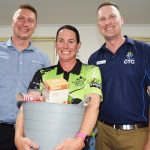




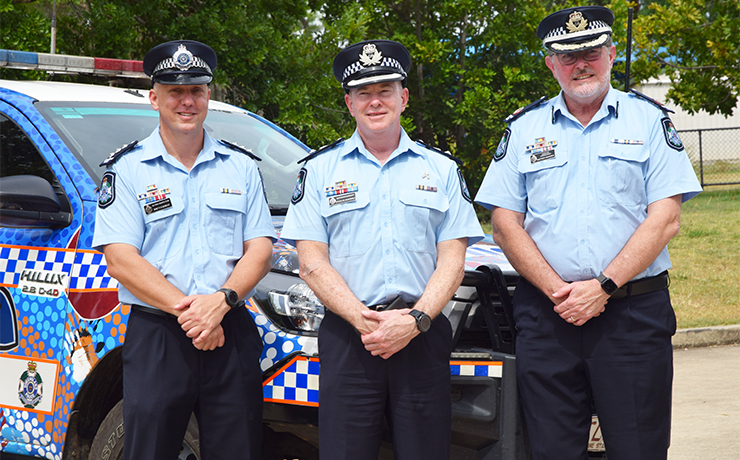
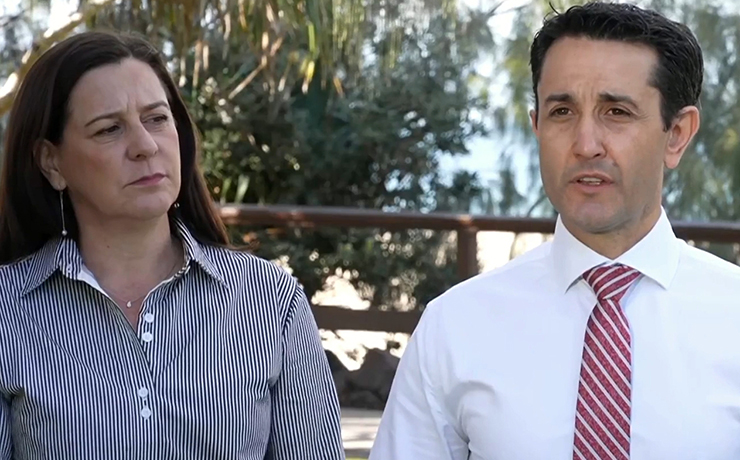
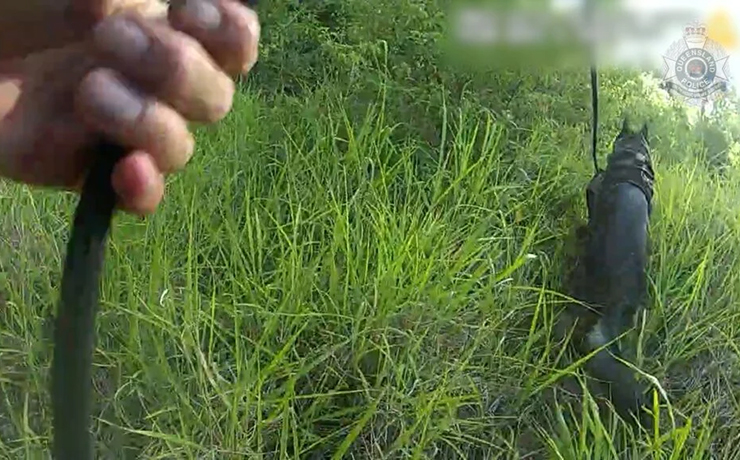






Gee, thanks for printing this. It should make any sensible person who reads it really sit up and think long and hard before doing things such as the people involved in the tragedies listed have done. It just shows how easily and quickly things can go so wrong.